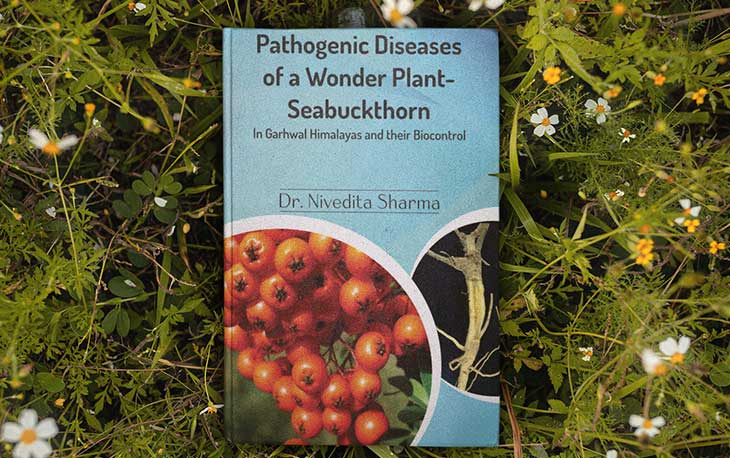The northern part of India harbours a great diversity of medicinal plants because of the majestic Himalayan range.
So far about 8000 species of angiosperms, 44 species of gymnosperms and 600 species of pteridophytes have been reported in the Indian Himalaya, of those 1748 species are known as medicinal plants.
The World Health Organization (WHO) estimated that 80% of the population of developing countries relies on traditional medicines, mostly plant drugs, for their primary health care needs.
Medicinal plants traditionally occupied an important position in rural and tribal lives of India and are considered as one of the most important sources of medicines since the dawn of human civilization.
Seabuckthorn is a general term given to the deciduous shrub tree Hippophae Linn.
It is one of the most magical plant resources with higher value of economy and ecology.
Not only this, the plant is equally important for firewood, fodder and serves as a variety of purposes including properties in the Indian Himalayan Region in general and in dry habits in particular.
Seabuckthorn plants collected and exploited unscientifically from Uttarakhand due to its use as food, medicines and cosmetics.
It is also known as “wonder plant” due to its multifarious benefits.
Therefore, Seabuckthorn should serve as a measure to safeguard medicinal and nutritional plants, to conserve biodiversity and environment and to generate sustainable income source for local people.
Despite although there are a few reports available regarding the pathological aspect of Hippophae spp. in India, but there is no systematic study on distribution and severity of diseases occurring on Hippophae salicifolia D. Don in Uttarakhand.
Hence, a systematic study was undertaken on the occurrence of diseases on Seabuckthorn plant which are responsible for negatively affecting its yield and quality and to search for effective biocontrol agents from the rhizosphere of the host plant.
Diseases and insects are the major factors affecting the success of Seabuckthorn cultivation. At present, few pests and diseases on Hippophae salicifolia have been reported. Control measures depend on proper identification of diseases and their causal agents.
Proper disease diagnosis is therefore vital as without proper identification of the disease and the disease causing agent, disease control measures are waste of time and money and can lead to further plant losses.
Additionally, the intensive use of fungicides for the control of diseases has resulted in the accumulation of toxic chemical which are hazardous to human beings and to the environment.
The increasing awareness of fungicide related hazards has emphasized the need for adopting a safer biological method and very little work has been done to search for microbial antagonists which could serve as biocontrol agents against diseases of Hippophae salicifolia.
Therefore, considering the paucity of knowledge coupled with the manifold medicinal, socio-economic as well as ecological significance of Seabuckthorn in Himalayan regions, the present investigation was framed.
A total of five diseases have been successfully identified alongwith the confirmation of causal fungal agents.
Though there were several other fungal species isolated and identified from the seabuckthorn eco-climate but only thirteen species were finally confirmed to cause above five diseases.
Thus, it becomes a part of maiden studies on this magical plant of Himalayan region which is seeking more attention for further investigation.
Treatment of valuable plant wealth is possible through the use of various pesticides, insecticides and other chemicals.
But chemical treatments are not ecofriendly and, therefore, effective bio-control mechanisms have some hope to treat such plants in a healthy vision.
Therefore, in this study efforts were also being made in this piece of research to find out some microbial antagonist among the isolated rhizospheric mycoflora that could act as bio-control agents against isolated pathogens.
For this purpose, Trichoderma harzianum was screened out for its antagonist ability against different pathogens.
Fortunately, it proved to be a success acting as strong antagonist against the pathogens.
To conclude, this preliminary study on the Seabuckthorn pathogens and biocontrol agent is a small effort in the natural habitats of fragile Himalayan ecosystems but nonetheless, opens new horizons of research in this challenging area of biological sciences.
Further, isolation of some newly recorded fungi from Seabuckthorn associated climate makes the study more interesting and opens the doors for new researchers in such a diverse habitats.
Author
-
Dr Nivedita Sharma is an Assistant Professor in the Department of Allied & Applied Science, University of Patanjali, Haridwar, Uttarakhand. She has completed Ph.D from Hemwati Nandan Bahuguna Garhwal University (A Central University) Srinagar, Uttarakhand, India. She has published remarkable review articles, chapters and more than a dozen research papers in elite National, International scientific impact factor journals. She is an active member of many national and international Research Organisations. She has got “Young Scientist Award” at the National Seminar sponsored by University Grants Commission, New Delhi on “Environmental Health vis-à-vis Human Welfare in Present Scenario” at Dehradun, Uttarakhand, India. She has qualified various prestigious national level examinations such as Uttarakhand State Eligibility Test (USET) in Life Sciences, UKPSC Lecturer Exam in Biology.
